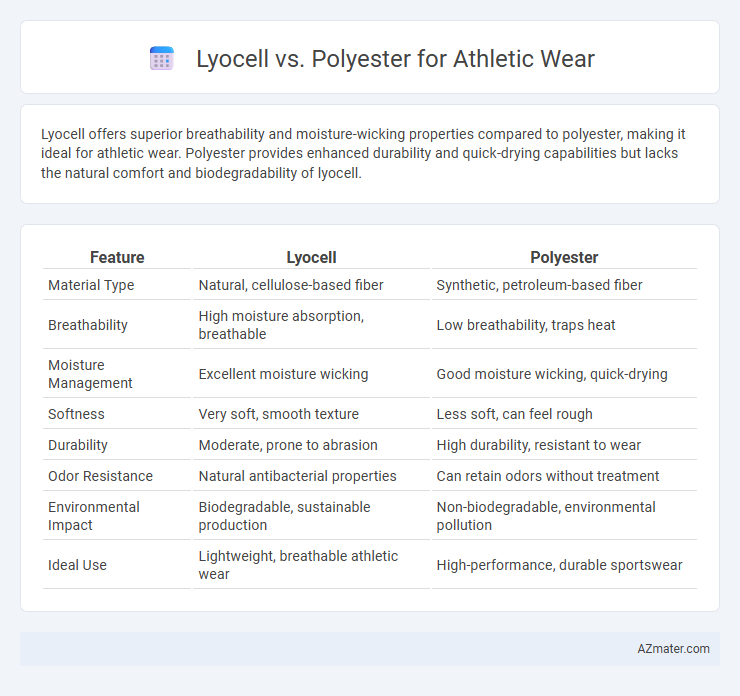Lyocell offers superior breathability and moisture-wicking properties compared to polyester, making it ideal for athletic wear. Polyester provides enhanced durability and quick-drying capabilities but lacks the natural comfort and biodegradability of lyocell.
Table of Comparison
| Feature | Lyocell | Polyester |
|---|---|---|
| Material Type | Natural, cellulose-based fiber | Synthetic, petroleum-based fiber |
| Breathability | High moisture absorption, breathable | Low breathability, traps heat |
| Moisture Management | Excellent moisture wicking | Good moisture wicking, quick-drying |
| Softness | Very soft, smooth texture | Less soft, can feel rough |
| Durability | Moderate, prone to abrasion | High durability, resistant to wear |
| Odor Resistance | Natural antibacterial properties | Can retain odors without treatment |
| Environmental Impact | Biodegradable, sustainable production | Non-biodegradable, environmental pollution |
| Ideal Use | Lightweight, breathable athletic wear | High-performance, durable sportswear |
Introduction to Lyocell and Polyester in Athletic Wear
Lyocell, a sustainable fiber made from wood pulp, offers exceptional moisture-wicking and breathability, making it ideal for athletic wear that requires comfort and environmental responsibility. Polyester, a synthetic fiber known for its durability and quick-drying properties, dominates athletic apparel for high-performance activities due to its strength and resistance to shrinking and stretching. Both fibers serve distinct purposes in athletic wear, with Lyocell promoting eco-friendly moisture management and polyester providing long-lasting support and shape retention.
Fabric Composition: Lyocell vs Polyester
Lyocell is a natural cellulose fiber derived from sustainably sourced wood pulp, known for its breathability, moisture-wicking properties, and biodegradability. Polyester, a synthetic polymer made from petrochemicals, offers high durability, quick-drying capabilities, and excellent shape retention, but lacks natural moisture absorption. The choice between Lyocell and Polyester for athletic wear depends on desired fabric performance, environmental impact, and wearer comfort.
Moisture-Wicking Abilities Compared
Lyocell exhibits superior moisture-wicking abilities compared to polyester due to its natural fibers that efficiently absorb and release sweat, keeping athletes drier during intense workouts. Polyester, while less absorbent, excels in quick-drying properties and durability, making it suitable for moisture management in high-performance athletic wear. The choice between Lyocell and polyester depends on whether enhanced moisture absorption or rapid drying is prioritized in athletic apparel.
Breathability and Comfort Factors
Lyocell offers superior breathability and moisture-wicking properties compared to polyester, making it ideal for athletic wear by effectively regulating temperature and reducing sweat buildup. The natural fibers in Lyocell enhance comfort with their softness and hypoallergenic qualities, minimizing skin irritation during intense physical activity. Polyester, while durable and quick-drying, tends to trap heat and moisture, which can lead to discomfort and chafing over extended workouts.
Durability and Strength Analysis
Lyocell offers superior moisture-wicking properties and breathability but generally lacks the tensile strength and abrasion resistance of polyester, which is engineered for high durability in athletic wear. Polyester fibers withstand repeated stretching and rigorous washing cycles without significant degradation, maintaining fabric integrity and shape retention over time. The combination of polyester's robust synthetic composition and Lyocell's natural comfort creates performance blends, yet pure polyester remains the preferred choice for strength and long-lasting athletic garment durability.
Odor Resistance and Hygiene
Lyocell offers superior odor resistance and hygiene compared to polyester due to its natural moisture-wicking and antimicrobial properties, which reduce bacteria growth and keep athletic wear fresher for longer. Polyester, while durable and quick-drying, tends to retain odors because synthetic fibers trap sweat and bacteria more easily. For athletes prioritizing odor control and hygiene, lyocell-based fabrics provide enhanced breathability and effective moisture management, minimizing odor buildup during intense physical activities.
Environmental Impact and Sustainability
Lyocell, made from sustainably sourced wood pulp, offers superior biodegradability and lower environmental impact compared to polyester, which is derived from non-renewable petroleum and contributes significantly to microplastic pollution. The closed-loop production process of Lyocell recycles water and solvents, reducing chemical waste and energy consumption, whereas polyester manufacturing involves high greenhouse gas emissions and reliance on fossil fuels. Athletic wear made from Lyocell supports eco-friendly practices by enhancing breathability and moisture management while minimizing landfill waste and ocean pollution.
Care and Maintenance Requirements
Lyocell athletic wear requires gentle washing in cold water and air drying to maintain its moisture-wicking and breathable properties without causing fiber damage. Polyester athletic wear is more durable with high resistance to shrinking, stretching, and wrinkles, allowing for machine washing in warm water and tumble drying on low heat without significant wear. Proper care of lyocell enhances its softness and biodegradability, while polyester's synthetic nature demands less maintenance but may retain odors and static if not washed regularly.
Cost Comparison for Consumers
Lyocell athletic wear generally costs more upfront than polyester due to its sustainable production processes and natural fiber benefits. Polyester garments are often cheaper and widely available, making them a budget-friendly choice for consumers prioritizing cost-effectiveness. Consumers seeking eco-friendly athletic wear may consider Lyocell's higher price justified by its biodegradability and moisture-wicking properties.
Which Fabric Wins for Athletic Wear?
Lyocell outperforms polyester for athletic wear due to its superior moisture-wicking properties, breathability, and biodegradability, making it ideal for high-intensity workouts and environmentally conscious consumers. Polyester excels in durability, quick-drying capabilities, and color retention, providing long-lasting performance in various sports conditions. For athletes prioritizing comfort and sustainability, lyocell is the winning fabric, while polyester remains a strong choice for affordability and resilience.

Infographic: Lyocell vs Polyester for Athletic Wear
 azmater.com
azmater.com